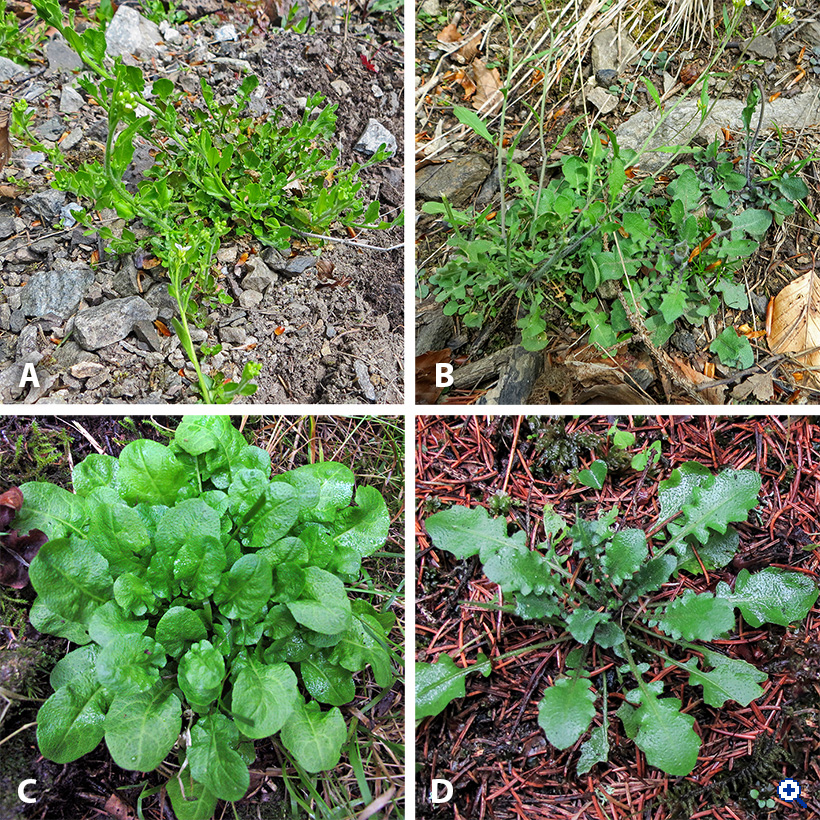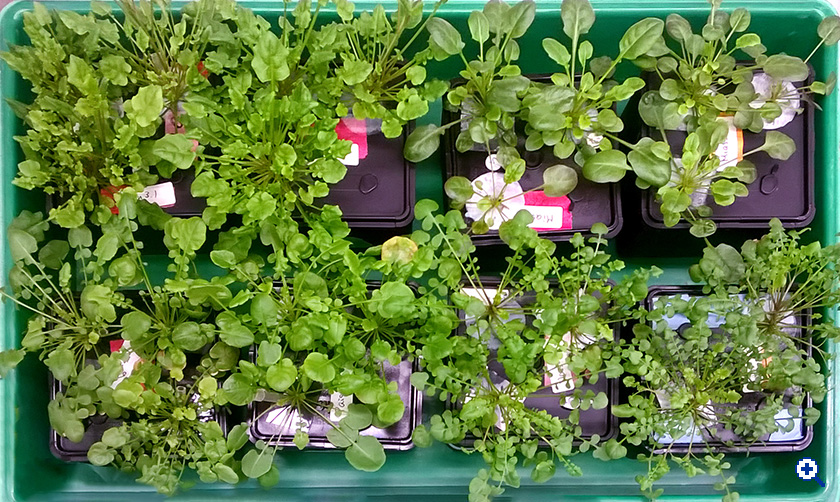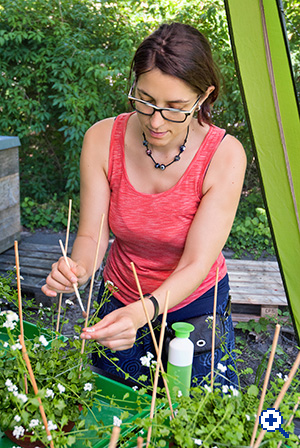Dr. Veronica Preite
About me
I am a plant biologist working in the field of terrestrial ecology and plant adaptation. I studied in Basel, Switzerland, and then for my Ph.D. project I went to the Netherlands Institute of Ecology (NIOO) in Wageningen, NL. I am investigating the role of genetic and epigenetic variation in adaptation of widespread European forbs to their local habitat. I surveyed natural populations of Campanula rotundifolia, Taraxacum officinale and currently I am working with Prof. Dr. Ute Krämer in the Department of »Molecular Genetics and Physiology of Plants« on Arabidopsis halleri and A. arenosa.
Since 2015 I am as a postdoctoral researcher working with metal hyperaccumulation and hypertolerance. Arabidopsis halleri is hypertolerant to Zn, Cd and Pb and therefore can be found (but not exclusively) growing on soils with high metal contamination (metalliferous). Arabidopsis halleri has also a special feature of hyperaccumulating Zn (>3000 mg kg-1 d.w.) and Cd (>100 mg kg-1 d.w.) in shoots. In A. arenosa there are a few populations that are tolerant to high Zn and Cd concentration in soil and, although it has been shown to accumulate high amounts of Cd and Zn in shoots, it is not a hyperaccumulator. Currently I am involved in research on 1) Adaptation to metal-contaminated soil and 2) Natural variation of gene expression in Arabidopsis halleri.
Research
Why studying Arabidopsis halleri and A. arenosa adaptation and natural variation?
We are looking for genes that are involved in the uptake and storage of vast amounts of trace metals in these plants. Trace metals such as cadmium, lead and nickel, depending on their concentration can be very toxic. Some of these metal genes we found already, but we are in search of many more. It is interesting to understand why hyperaccumulation evolved - what is the benefit for the plant? Potentially hyperaccumulating plants use these toxic elements in their leaves to defend themselves better against herbivores. Ultimately, information on the genetic and physiological mechanism of metal tolerance and accumulation (uptake and storage) can be used in the research field of biofortification (e.g. breeding crops with higher levels of zinc and iron) and in remediation of metal polluted soils (e.g. legacy from mining sites and using cadmium rich phosphate fertilizer).
Figure 1 (A) A. halleri (Lower Silesia Province PL), (B) A. arenosa (Lower Silesia Province PL, (C) A. halleri (Sauerland DE,) (D) A. arenosa (Sauerland DE)
Here an overview of the projects I am currently working on:
1) Adaptation to metal-contaminated soil
(a) We use reciprocal soil exchange under controlled growth chamber conditions to test for local adaptation at field sites harboring natural A. halleri and A. arenosa populations. To do so, we are growing plants originating from either non-contaminated or contaminated field sites on two contrasting soil conditions, that is, (i) soil containing low/ordinary levels of trace elements or (ii) high metal content, which would be toxic to most of other plants (within project »SPP1819 - Rapid evolutionary adaptation«)
(b) We investigate adaptation to local soil type in A. halleri under more natural conditions with a reciprocal field transplant experiment. Two contrasting A. halleri populations are used: one from a metal-contaminated growth site and one from a non-contaminated growth site. A. halleri plants from both origins are growing for one full season at these two growth sites and afterwards we harvest and analyses the plants (fitness traits).
(within project »DFG-SPP 1529 ADAPTOMICS«).
2) Natural variation of gene expression in Arabidopsis halleri
Here we look into natural variation at the gene expression level in A. halleri using RNA-seq data from a common garden hydroponics experiment using natural A. halleri population pairs from three geographic regions within Europe. Each population pair consists of a field site classified as non-contaminated and one classified as contaminated field site. Differentially expressed genes will be further investigated and can help to identify new candidate genes in plant adaptation to metal-contaminated soils.
Figure 2 Various A. halleri genotypes growing in hydroponics
Education
- Since Aug 2015, postdoc, Department of Molecular Genetics and Physiology of Plants, Ruhr University Bochum, Germany;
- April 2011 - Aug 2015: Ph.D., Department of Terrestrial Ecology, Netherlands Institute of Ecology (NIOO), Wageningen, The Netherlands. Ph.D. Thesis defended on 7. Sept. 2016; Title: “Epigenetic inheritance in apomictic dandelions”; research advisor: Dr. Koen Verhoeven, advisor: Prof. Wim van der Putten;
- October 2004 - March 2010: Bachelor in Biology, University of Basel/Zürich, Switzerland, and Master in Plant Ecology and Population Genetics, Botanical Institute, University of Basel, Switzerland. Master Thesis title: “Genetic adaptation of flowering traits to climate change in the harebell”; research advisor: Dr. J.F. Scheepens, advisor: Prof. J. Stöcklin
Teaching
- Practical course week: metal homeostasis / molecular biology of plants (in german: A-Modul Metallhomöostase /Molekularbiologie der Pflanzen 190085 – WiSe 17/18 und WiSe 19/20), Ruhr University Bochum
- Practical course day: photosynthesis / practical course in plant physiology (in german: Photosynthese / Pflanzenphysiologische Übungen 190012 – SoSe18), Ruhr University Bochum
- Supervision of bachelor students: S-Block/student project (2018) and bachelor thesis (2019), Ruhr University Bochum
- Assistance in practical courses determination of plant species and botanical microscopy (2009), University of Basel
Publications
- Lee G, Ahmadi H, Janina N, Preite V, Quintana J, Syllwasschy L, Anderson JE, Pietzenuk B, Krämer U (2019)
Enhanced genome integrity maintenance and few large stress-mitigating alterations characterize the transcriptome of extreme habitat-adapted Arabidopsis halleri. bioRxiv preprint
https://doi.org/10.1101/859249 - Preite V, Sailer C, Syllwasschy L, Bray S, Ahmadi H, Krämer U, Yant L (2019) Convergent evolution in Arabidopsis halleri and Arabidopsis arenosa on calamine metalliferous soils. Philosophical Transactions Royal Society B, 374:20180243.
https://doi.org/10.1098/rstb.2018.0243 - Preite V, Oplaat C, Biere A, Kirschner J, van der Putten WH, Verhoeven KJF (2018) Increased transgenerational epigenetic variation, but not predictable epigenetic variants, after environmental exposure in two apomictic dandelion lineages. Ecology and Evolution, 8:3047–3059. https://doi.org/10.1002/ece3.3871
- Rendina Gonzalez AP, Preite V, Verhoeven KJF, Latzel V (2018) Transgenerational effects and epigenetic memory in the clonal plant Trifolium repens. Frontiers in Plant Science, 9:1677. https://doi.org/10.3389/fpls.2018.01677
- Morgado L, Preite V, Oplaat C, Anava S, Ferreira de Carvalho J, Rechavi O, Johannes F, Verhoeven KJF (2017) Small RNAs reflect grandparental environments in apomictic dandelion. Molecular Biology and Evolution, 34:2035–2040.
https://doi.org/10.1093/molbev/msx150 - Foust CM, Preite V, Schrey AW, Alvarez M, Robertson MH, Verhoeven KJF, Richards CL (2016) Genetic and epigenetic differences associated with environmental gradients in replicate populations of two salt marsh perennials. Molecular Ecology, 25:1639–1652.
https://doi.org/10.1111/mec.13522 - Huber M, Epping J, Schulze Gronover C, Fricke J, Aziz Z, Brillatz T, Swyers M, Köllner TG, Vogel H, Hammerbacher A, Triebwasser-Freese D, Robert CAM, Verhoeven KJF, Preite V, Gershenzon J, Erb M (2016) A latex metabolite benefits plant fitness under root herbivore attack. PLoS Biology 14:e1002332. https://doi.org/10.1371/journal.pbio.1002332
- Preite V, Snoek LB, Oplaat C, Biere A, van der Putten WH, Verhoeven KJF (2015) The epigenetic footprint of poleward range-expanding plants in apomictic dandelions. Molecular Ecology, 24, 4406–4418. https://doi.org/10.1111/mec.13329
- Preite V, Stöcklin J, Armbruster GFJ, Scheepens JF (2015) Adaptation of flowering phenology and fitness-related traits across environmental gradients in the widespread Campanula rotundifolia. Evolutionary Ecology, 29: 249–267. https://doi.org/10.1007/s10682-015-9754-y
- Verhoeven KJF, Preite V (2013) Epigenetic variation in asexually reproducing organisms. Evolution, 68: 644–655.
https://doi.org/10.1111/evo.12320










